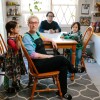Kira Portnaya, 35

Kira Portnaya
Age: 35
Hollywood
Wednesday, March 9, 2022
I was born in Samara, Russia. In 1996, when I was 10 years old, we moved to the Washington DC suburbs of Gaithersburg, Maryland. My grandmother, Khaya, was born in Kyiv. At the beginning of World War II, before the Nazis came to Ukraine, she escaped and went to Russia where she eventually settled and had a family. My mother is Jewish, and there's still a lot of discrimination that she felt growing up, especially during the Soviet era. My grandmother’s sister moved to Maryland several years before us and she sponsored our arrival.
I moved to L.A. a year ago, in the middle of COVID. I was offered a job in December of 2020 and decided to start the new year in a new place. I was looking for personal growth and a change of scenery.
I did get a chance to visit Kyiv twice in my life, once as a child and then again in my early 20s. Around 2011, I was working for a company in Maryland with a recruitment office in Kyiv and I got to go there for a week. It was absolutely gorgeous and vibrant and everybody was so friendly. I remember this one particular girl, her name was Lena. She was my administrative assistant and she was just this beautiful spirit. She spent time hanging out with me and showing me around the city -- taking me to cute cafes and fun clubs, you know, the key to city life in your early 20s. Then I got to meet her family. They lived in the converted dacha [country home] that had become their full-time residence. They had gardens and made "shashliki" (shish kebabs); they were super hospitable. It was a beautiful time.
I haven't really been part of the local Russian or Russian-speaking communities, aside from a few friends here and there. My Russian cultural identity wasn't the one I foregrounded. I prioritized a lot of my other identities: woman, creator, marketer, artist, you name it. But now, my Eastern European heritage is one I have to start connecting with more. I’m coming to terms with my birth land and the pain that it's inflicting not just on Ukraine, but on the rest of the world. I can choose to ignore it and avoid it or I can choose to face it and acknowledge it. And to choose the right side of history. As I am facing my Russian identity, I'm also acknowledging that I’m a citizen of the world. This is a global world and what we do affects people in other places.
I hope we open up our arms here in the U.S. and take these refugees. And, I also think we should be just as open to other refugees coming from other countries. Nobody uproots their life and comes to an unfamiliar place where they don't speak the language for no reason. When I came here as a child, an immigrant, not speaking any English, we didn't experience any major push back. My grandmother and my mother didn't have any problems with the government. I mean, an immigrant experience is never easy. But by all accounts, compared to what you hear certain cultures going through right now, my family’s experience was easy. I hope that every refugee gets to have the same experience here.













